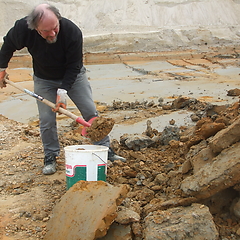Several steps are to be distinguished in the production process of mechanical clog making. It is done with relatively simple machines, running at rather low speed. The machines are driven from a central point, the electric engine, with leather belts. First of all the wood is sawn or split. When the outer shape of the clog has been trimmed, the inside of the clog is drilled to the proper size. Moulds are used to achieve an optimum fit. The clog must be dried. Finally it is sanded and processed. Setting the machines right requires a high level of craftsmanship, knowledge of the properties of the wood and the machines. It is a technical challenge to produce a pair of clogs in a mechanical way. There is an annual, national clog inspection, where mechanically produced clogs are tested. They are judged for fit, model and quality. The manufacturer who is selected champion, is awarded the Silver Clog.



